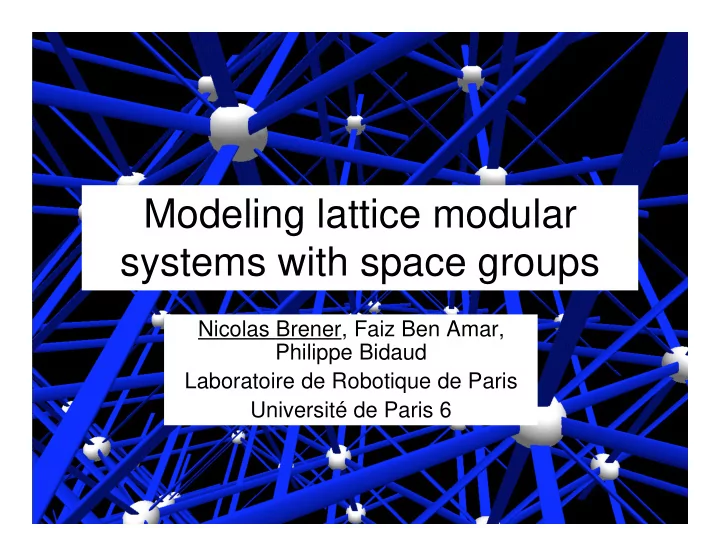

Modeling lattice modular systems with space groups Nicolas Brener, Faiz Ben Amar, Philippe Bidaud Laboratoire de Robotique de Paris Université de Paris 6
Lattice Robot vs Crystal • Lattice Robot • Crystal –Connectors have discrete –Atoms have discrete positions in a lattice positions in a lattice –Mobilities act on the –Symmetries act on position of the connectors the atoms positions –Mobility are discrete –Symmetries are motions discrete isometries • Use of crystallographic knowledge – Discrete Motion � Chiral space groups – Connectors position � Wyckoff sets
Outline • Discrete motion spaces – Point groups – Lattice groups – Space groups • Wyckoff positions • Group hierarchy • Classification of lattice robots • Design of lattice robots • Next steps
Transformation Groups taxonomy Isometry (length preserved) Motion (length and orientation preserved) Continuous 3D Isometry SE3 group SO3 Translations group Subgroup point groups 230 Crystallographic Discrete rotation Space groups types groups Subset 65 Chiral Space Groups Discrete types (Sohncke Groups) 32 Crystallographic point groups 11 Crystallographic 14 Lattice groups rotation groups types
Discrete motion spaces • Discrete rotation � chiral point group • Discrete translation � lattice group • Discrete motion � chiral space group
Discrete motion spaces • 11 chiral point Geometric elements groups (rotation groups) – Finite sets • Point group 622 – 12 rotations – 1 6-fold axes – 6 2-fold axes – Generator: 6-fold rotation { 180° rotation along x, 60° rotation along z } 2-fold rotation
Discrete motion spaces Geometric elements • Point group 432 – 24 rotations – 3 4-fold axes – 4 3-fold axes – 6 2-fold axes – Generator: { 90° rotation along x, 90° rotation along y } 4-fold rotation 3-fold rotation 2-fold rotation
Discrete motion spaces • Lattice groups • Cubic face centered lattice – Infinite sets – Generators: 3 translations – 14 types {(a,a,0),(a,0,a), (0,a,a)} • Cubic lattice • Hexagonal lattice {(a,0,0),(0,a,0),(0,0,a)} {(a,0,0),(a/2, a � 3/2, h)} • Cubic centered lattice • Triclinic lattice {(-a,a,a), (a,-a,a), (a,a,- { A , B , C } a)}
Discrete motion spaces • Chiral Space Group – Infinite sets – Have rotations and translations (and screw) – 65 types – Described in the « International Tables for Crystallography » edition th. Hahn
Discrete motion spaces Geometric elements of P622, except screw axes 6-fold 3-fold 2-fold
Discret motion spaces Geometric elements of P432, except screw axes 4-fold 3-fold 2-fold
Discret motion spaces Geometric elements of F432, except screw axes 4-fold 3-fold 2-fold
Wyckoff positions and Connectors Orthogonal rotation symmetry 6-fold 4-fold 3-fold 2-fold identity identity 2-fold Tangential rotation symmetry
Space Group Hierarchy
Space Group Hierarchy P432 Maximum chiral P622 F432 space I432 groups 60 other chiral space groups Minimum P1 chiral space group •Classification � Minimum space group •Design in Maximum groups
Classification • M-tran – Mobilities match 4-fold axes of F432 – Connectors match Wyckoff position e – The connectors have 4-fold symmetry
Classification Lattice System Space Connector Group Wyckof Symmetry orientation position M-tran F432 e 4-fold (1,0,0) I-Cube P432 e 4-fold (1,0,0) Telecube P1 a,a,a None NA Atron F432 j,j None NA Molecule F432 e 4-fold (1,0,0) 3D universal F432 j None NA
Designing Choose a space, and corresponding wyckoff position(s) and orientation(s). A module is constructed by selecting some mobilities and connectors and gluing them together Example: in F432 with 1 position in (a)
Designing Choose a space, and corresponding wyckoff position(s) and orientation(s). A module is constructed by selecting some mobilities and connectors and gluing them together Example: in F432 with 1 position in (a)
Designing Choose a space, and corresponding wyckoff position(s) and orientation(s). A module is constructed by selecting some mobilities and connectors and gluing them together Example: in F432 with 1 position in (a)
Designing Choose a space, and corresponding wyckoff position(s) and orientation(s). A module is constructed by selecting some mobilities and connectors and gluing them together Example: in F432 with 1 position in (a)
Designing Choose a space, and corresponding wyckoff position(s) and orientation(s). A module is constructed by selecting some mobilities and connectors and gluing them together Example: in F432 with 1 position in (a) 4-fold 2-fold 3-fold Rotation axis Node Connexion plate
Conclusion • Chiral Space groups give: – All possible mobility – All possible orientation, position and symmetries for connectors • Lattice design but chain type product (ex: M-tran) • Provides a framework to design several compatible systems, or extend existing systems with new modules. • But: it does not provide automatically an operational modular system… – Collision – Joint stops – …
Further steps • Formalize and automate classification. • Find rules on connector positions and mobilities that provide systems that efficiently reconfigure. • Develop a design interface.
Recommend
More recommend